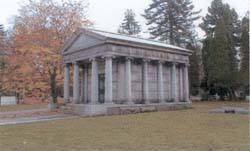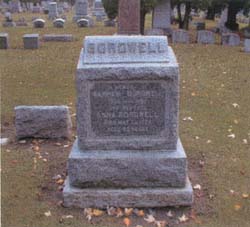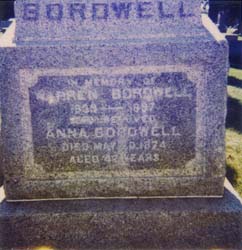
Home
- Artifacts
- Buildings & Businesses
- Churches
- Holidays & Celebrations
- Counties/Locations
- Delta College
- Early Settlers
- Ethnic Background
- Local, Michigan, U.S. and World Events
- Family Genealogy
- Farming
- Libraries & Museums
- Local Sites
- Logging
- Musicians, Artists & Famous People
- Nature, Weather & Four Seasons
- Railroads
- Schools
- Sports
Warren Bordwell—His Final Resting Place
 |
Entering through the decorative black wrought iron gates of Forest Lawn Cemetery, a cool crisp breeze hits my face; the smell of fall instantly strikes my nose. It is the smell of wet leaves and smashed pumpkins, all in one whiff. Hundreds of headstones resting on graves are the first sight I see. Leaves blow across the lane as I drive, searching for Section Twelve, the site where Warren Bordwell, the famous Saginaw Opera House owner back in the 1800s, was laid to rest.
As the road divides into three directions, I go to the right. Driving down further, I see Section 12 written in white lettering on a rusted green sign standing in the corner of the section.
The hunt for his tombstone has begun. I am searching for Bordwell, because he is
someone who interested me when reading the Stuart Gross book, The Saginaw's: When Timber Was King, and I know he rests here in Saginaw. With each step I take, the leaves crack and crunch, making a loud noise that disturbs the peaceful grounds. The sound of cars can be heard faintly in the distance, like a whispering silence. Crickets chirp and birds sing their own songs. Church bells are heard in the distance and sound beautiful. I pass many headstones of others, and thoughts linger in my mind as to how they had all passed away. Reading the names on headstones that weren't worn away with age gives me a gloomy sense of being unfulfilled. I am sad and weakened with feelings that somehow there may be a connection with this place and myself. It gives me an unsettled impression, because I don't know what it is. Is it confusion, instinct, or just my imagination?
Finally, I spot Warren Bordwell's grave. His headstone looks like it had been fixed, with just the large top portion looking like it had been broken in half because there's a white calk that proceeds all the way around. The headstone feels coarse, like a nail file pressed firmly against my fingertips. The only smoothness on the headstone is Bordwell's last name spelled out across the top rounded portion, where all his information reads:
 |
IN MEMORY OF WARREN BORDWELL 1839---------1897 AND BELOVED ANNA BORDWELL DIED MAY 20, 1874 AGED 42 YEARS |
My surroundings seem to be like a far away place, a whole different world to me. Then, the blue sky with little tricklets of white clouds and the bright and beautiful sun shining on the wondrous colors of fall suddenly revive me with happiness. Large trees look as if they almost reach heaven. Their trunks are rounded and seem to stay that way as they reach so high for the sky. The colors of red, orange, yellow, and green on the trees brighten up the sight, yet every tree branch hangs as if in grief, that they had knowledge of Warren Bordwell's past and how his abusive temper had the best of him: If something went wrong or Bordwell didn't get his way, he had the power to harm whoever was near, usually just the women. Once, he beat a girl so bad that she was hospitalized; and he had no remorse for doing it.
 |
The other tombs around the area where Bordwell lay are quite large, some holding at least four bodies. They all look different; not one is the same as any other. They are all from a different time period, the late eighteenth and early nineteenth century. They sit on the corners of each section, each one with its own pathway leading to locked doors. They are decorated beautifully and made of concrete.
This enormous cemetery has over 50,000 bodies that have been laid to rest. The headstones off all the deceased don't look well kept. They are dirty and covered with leaves, stained with moss and some other white crud that developed throughout the years. The dates on the headstones show the oldness as well as the appearance of the place. The oldest tomb that I found dated back to the late seventeen hundreds, the Webber family.
Cemeteries are an important part of people's lives. They hold a special bond between the deceased and the living. They are a place of remembrance and a place to escape from the real world, but death is still the reality. If every one were to be cremated, would people still feel that bond with the deceased? Could you go to that place that makes you feel alone and free? Cemeteries hold important information to the past, buried six feet into the ground.
| The written and visual works in Mid-Michigan Remembers-Stories about Us were chosen on the basis of their quality, diversity, community interest and appeal. Views expressed do not necessarily reflect those of the College. This space is provided as a service by Delta College. |